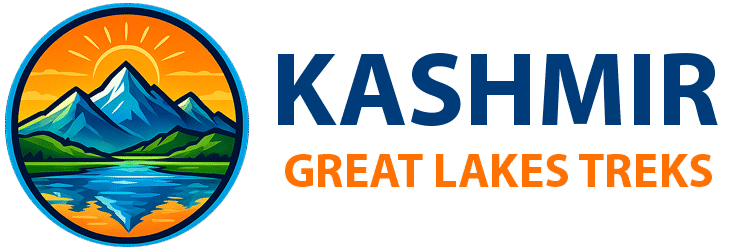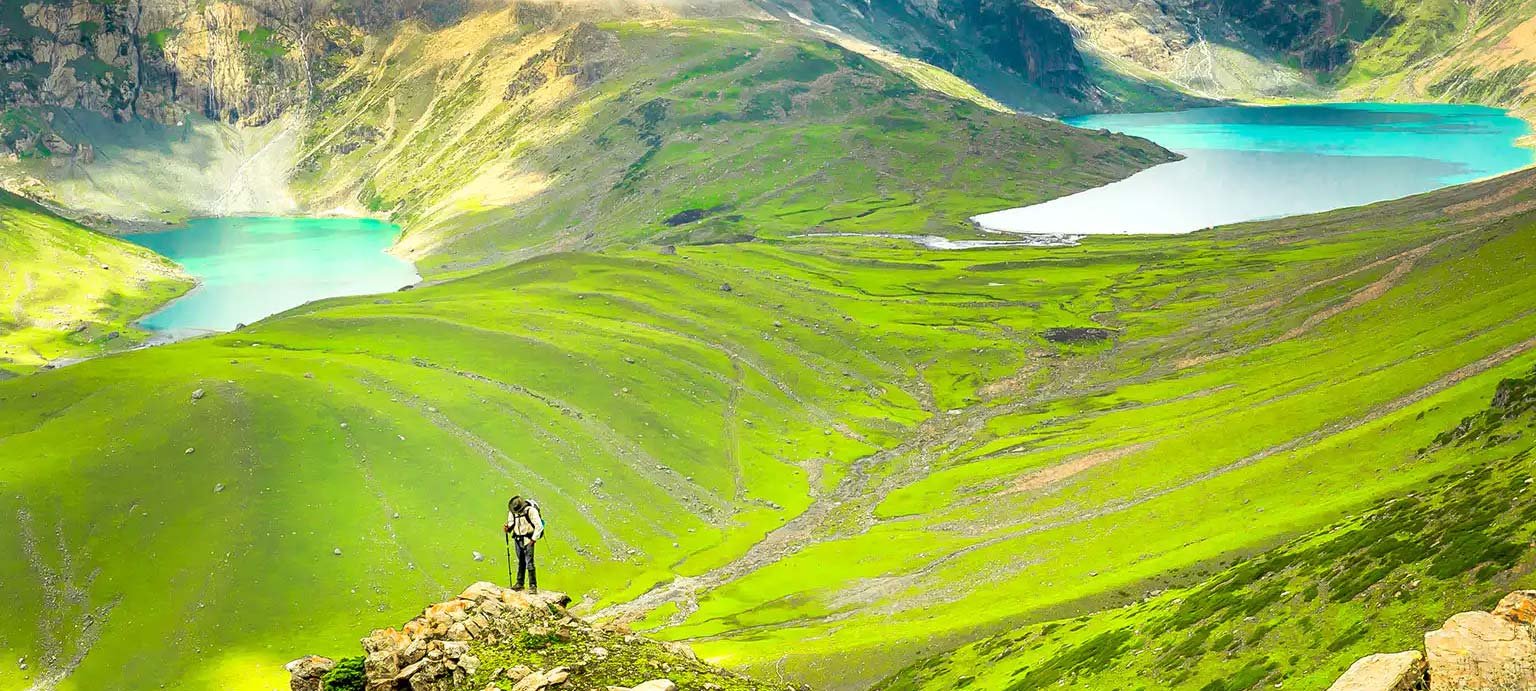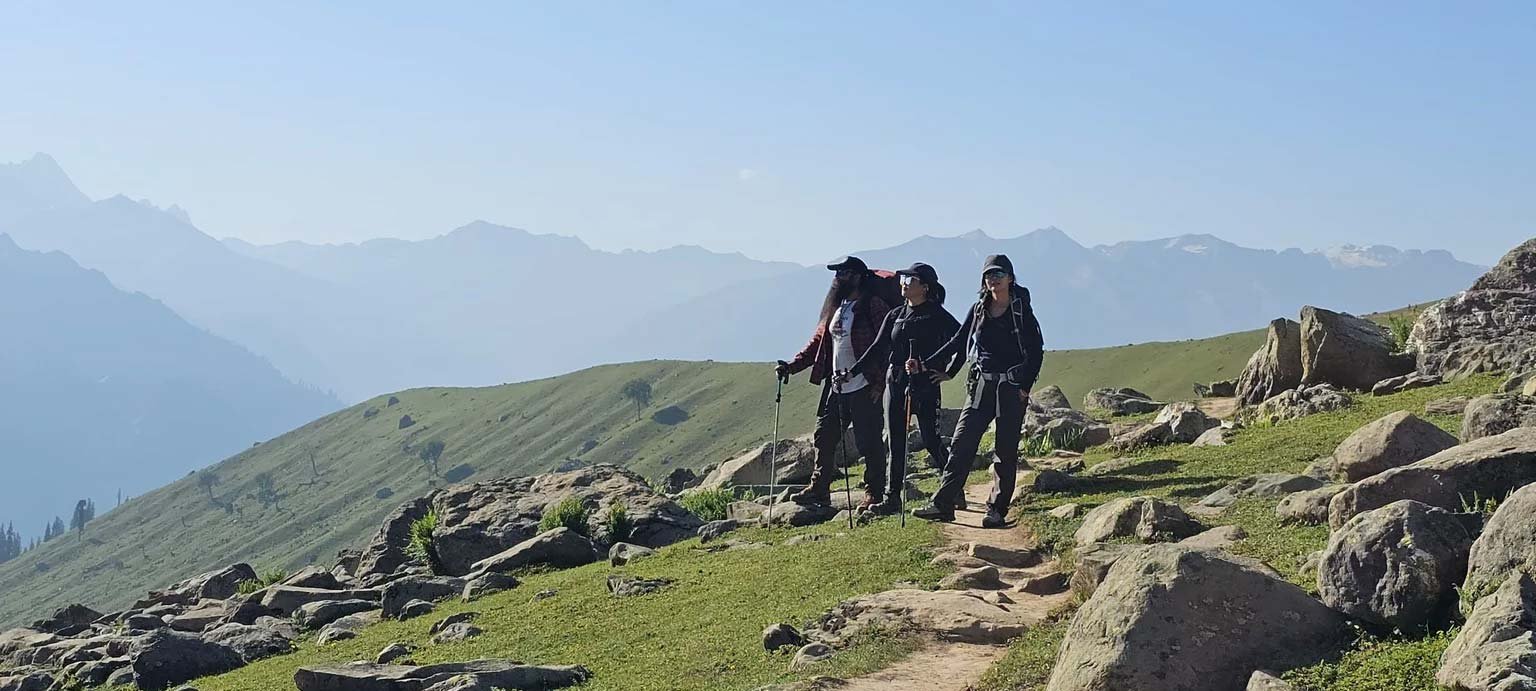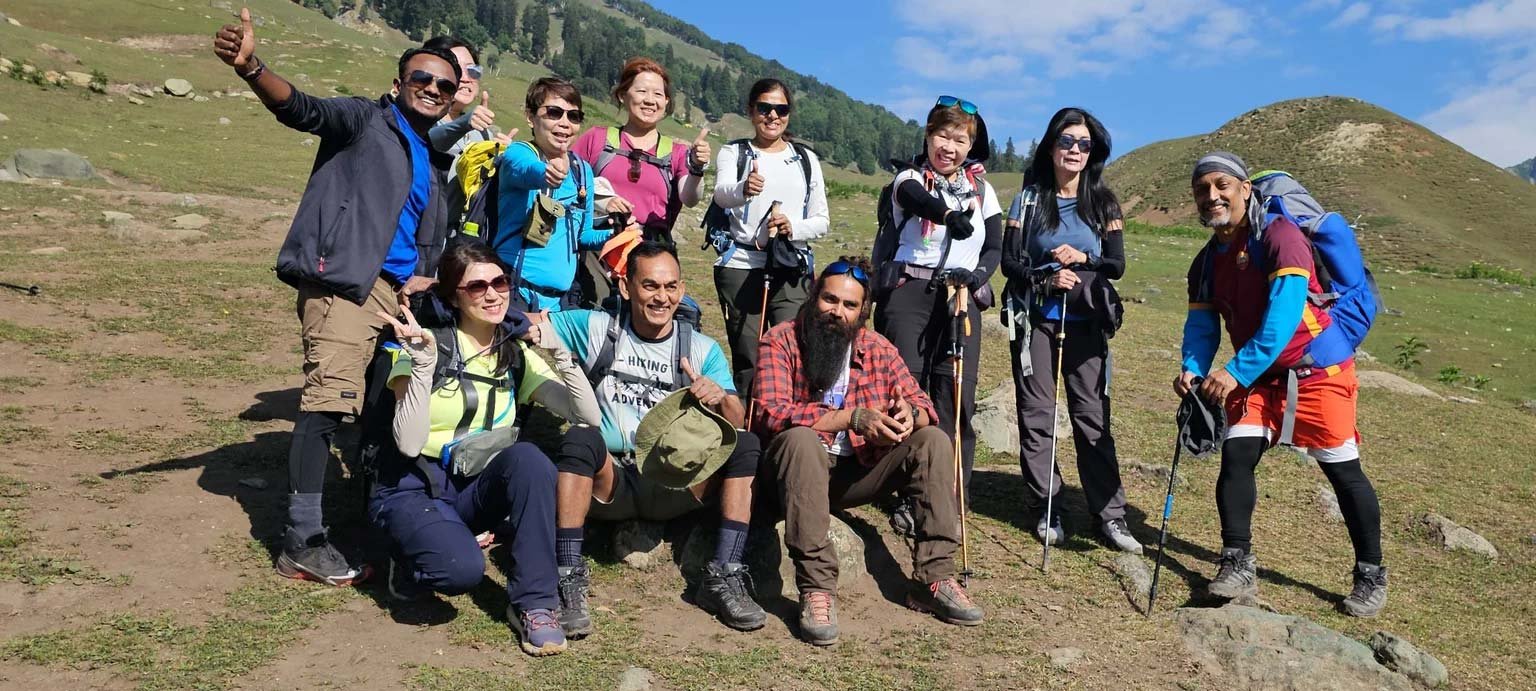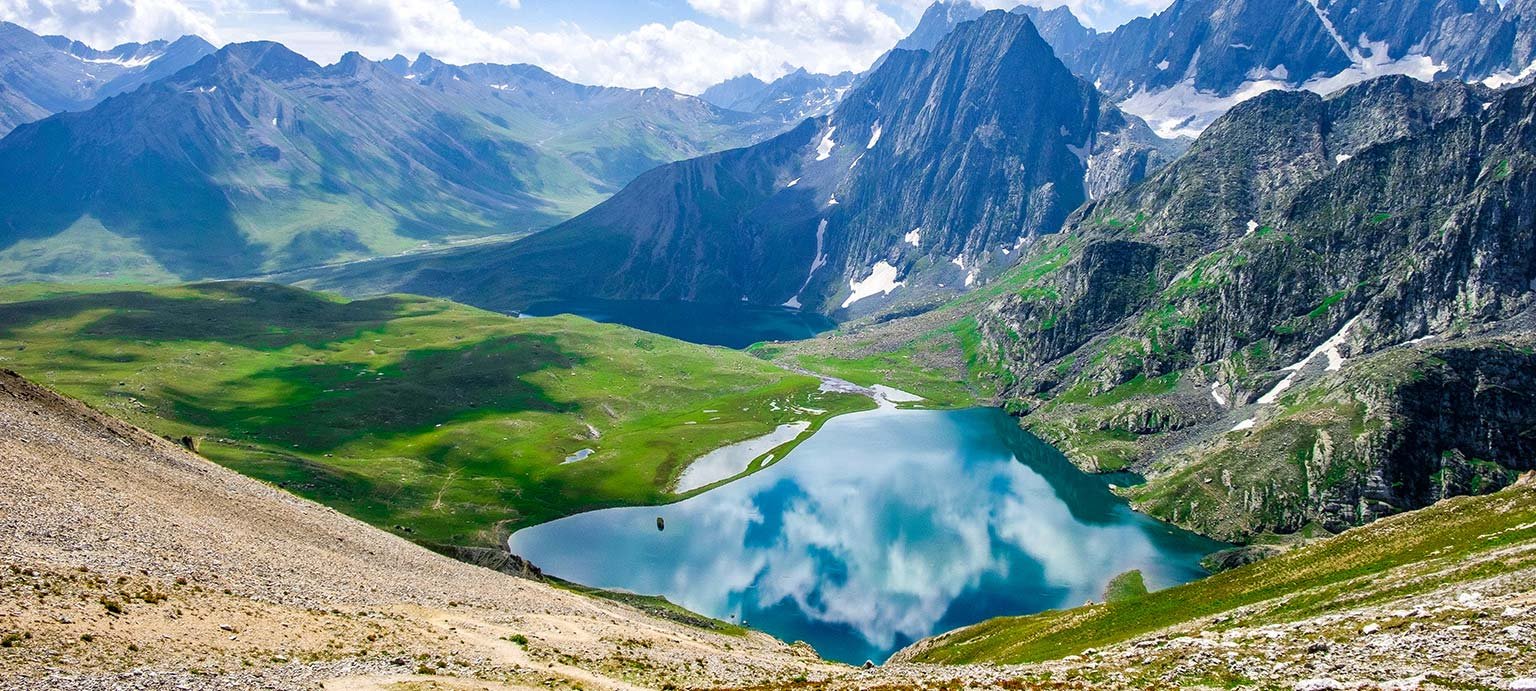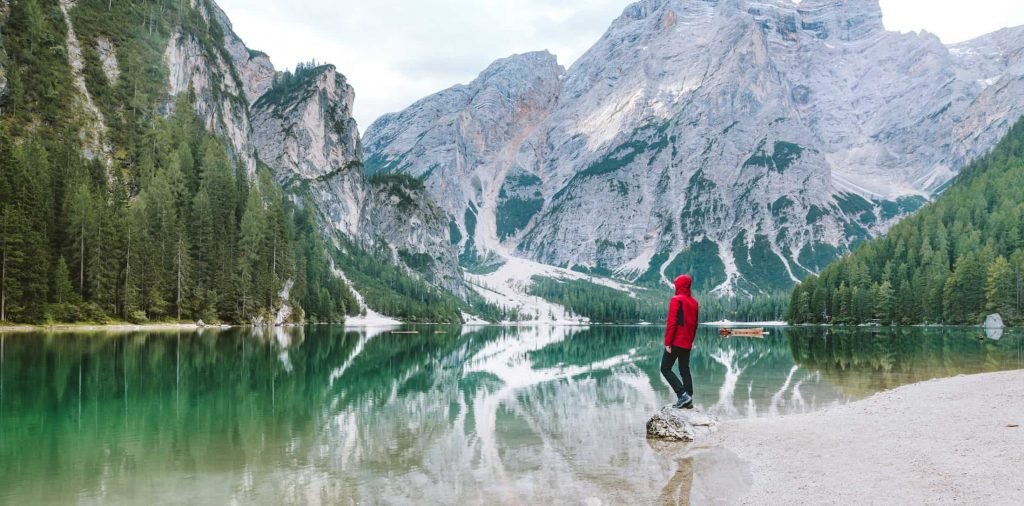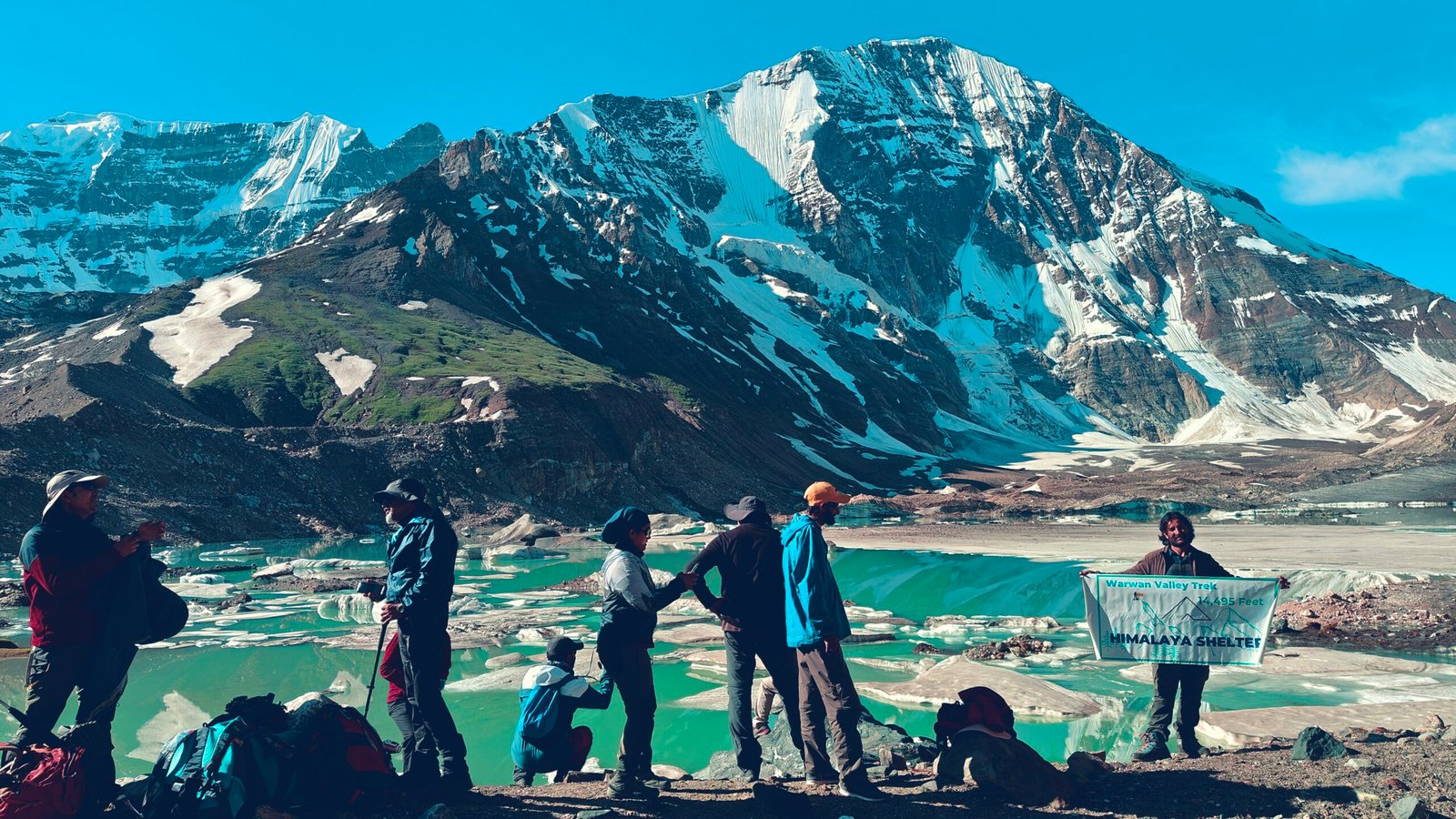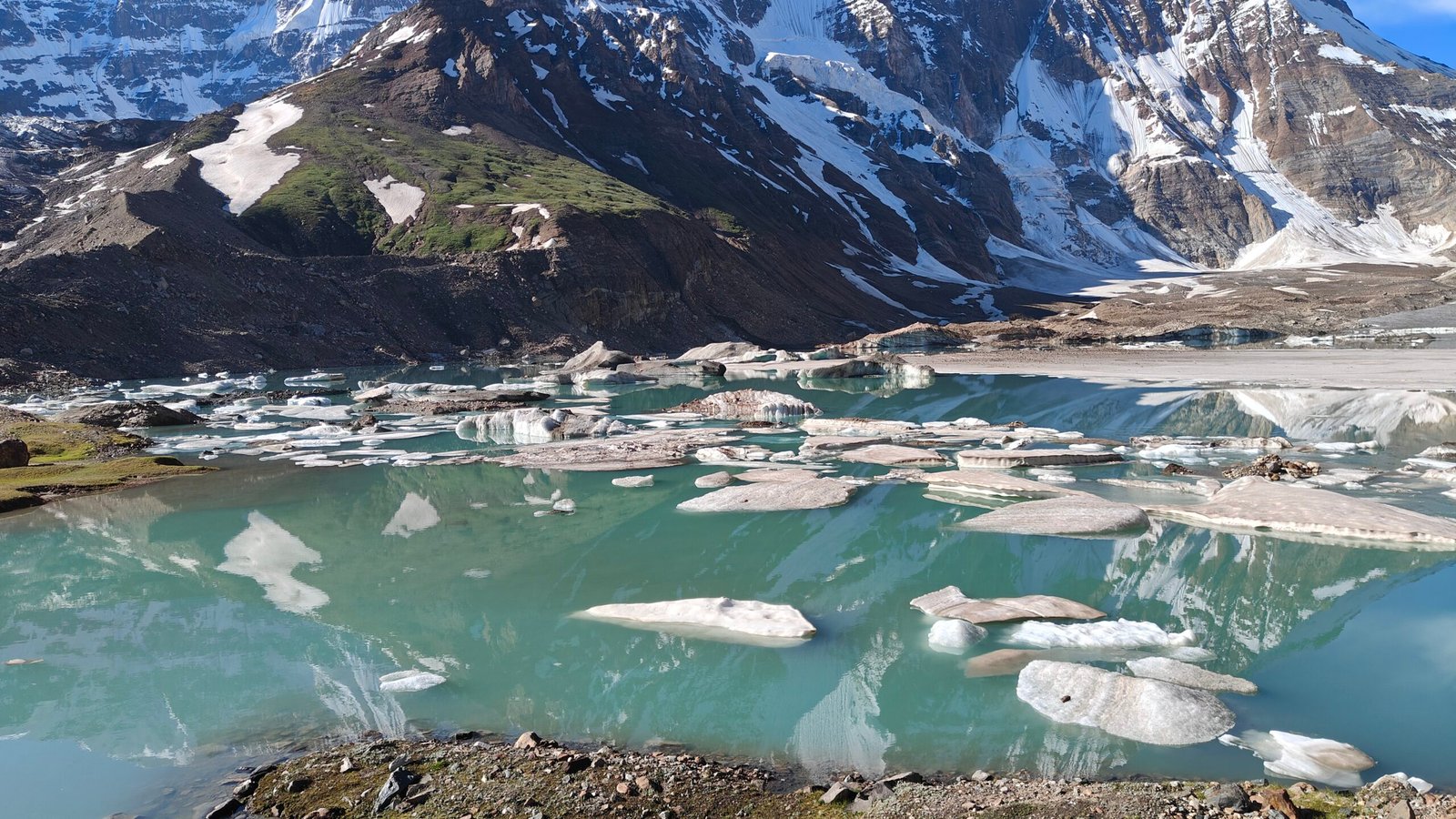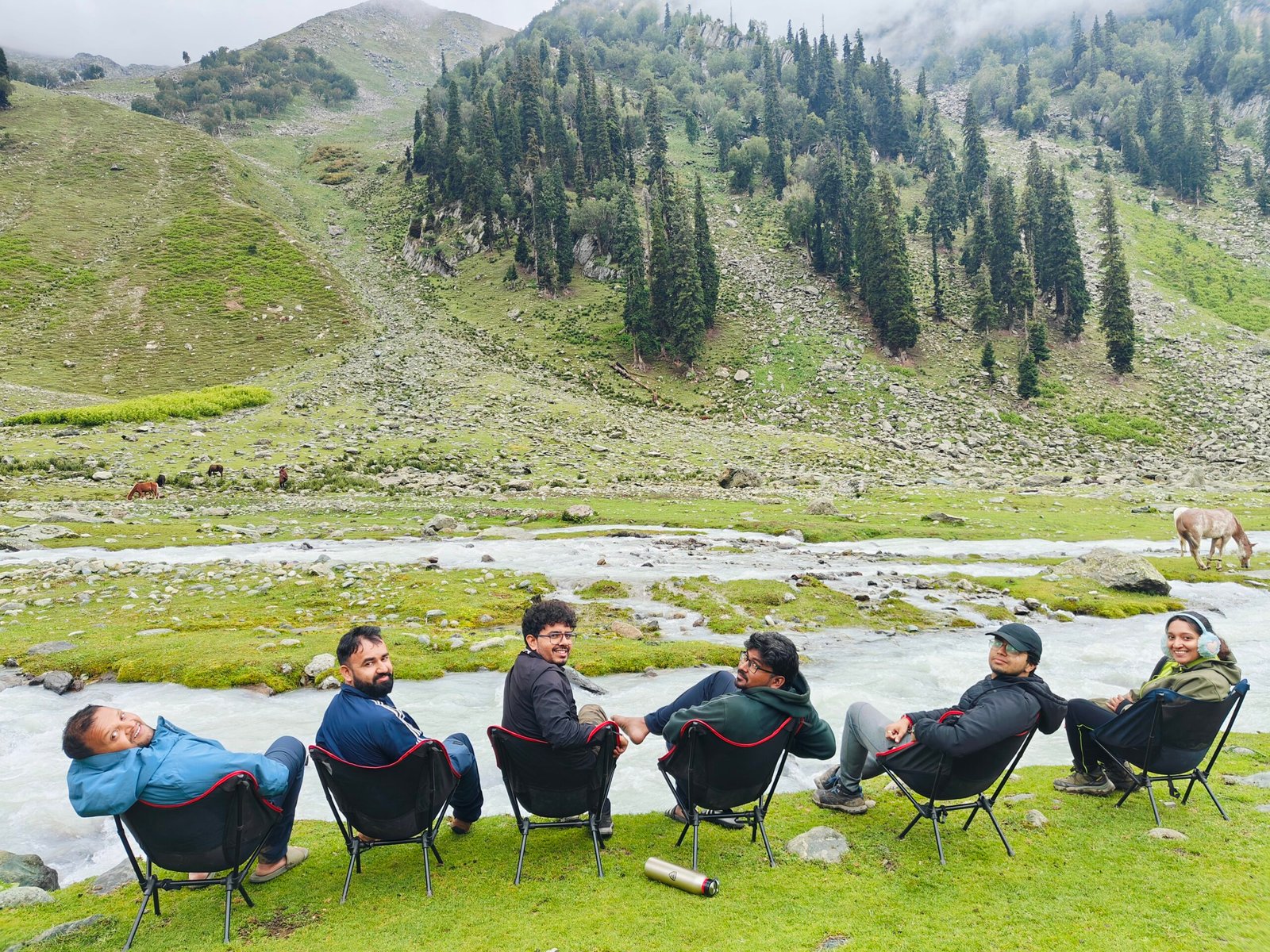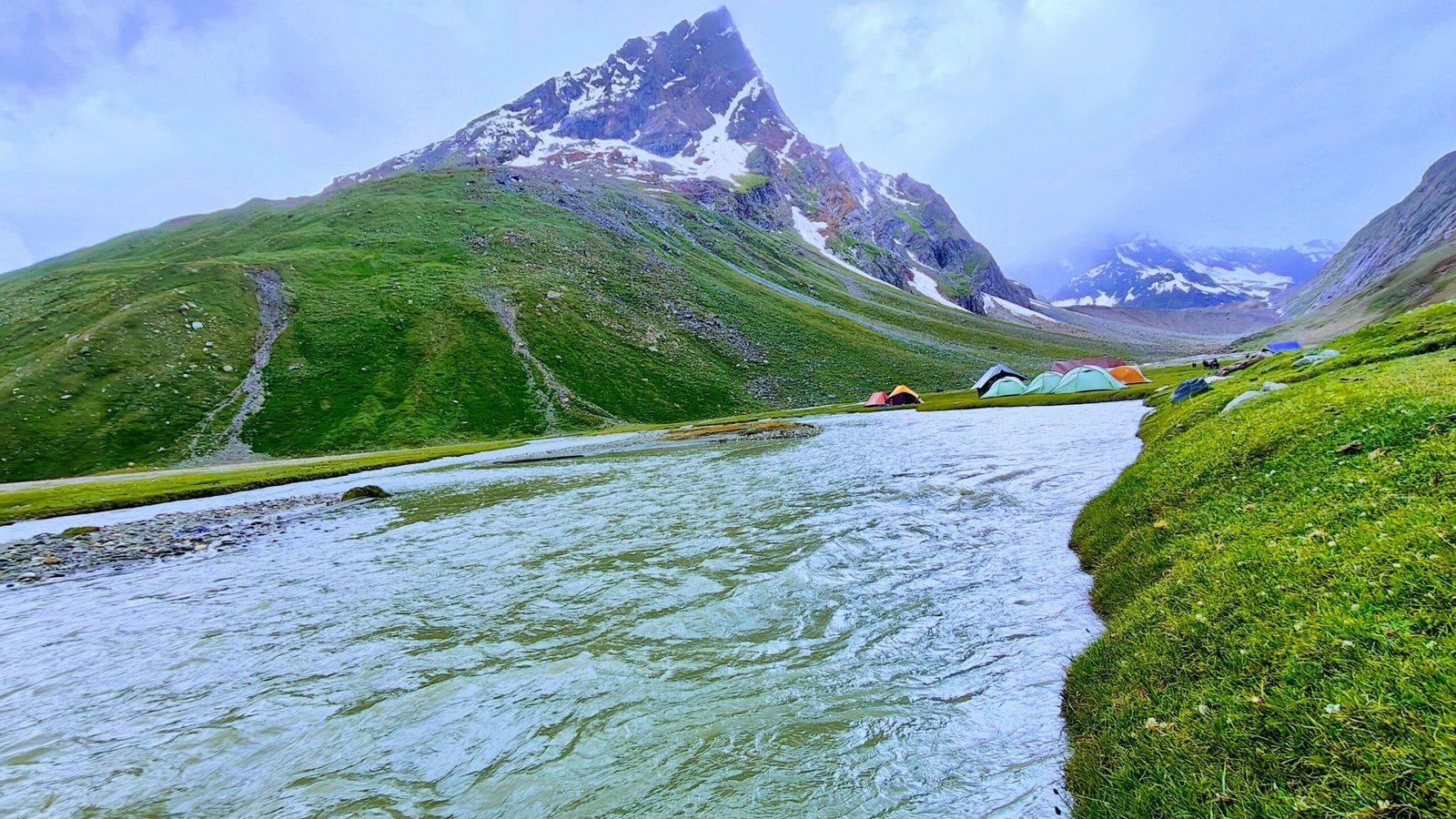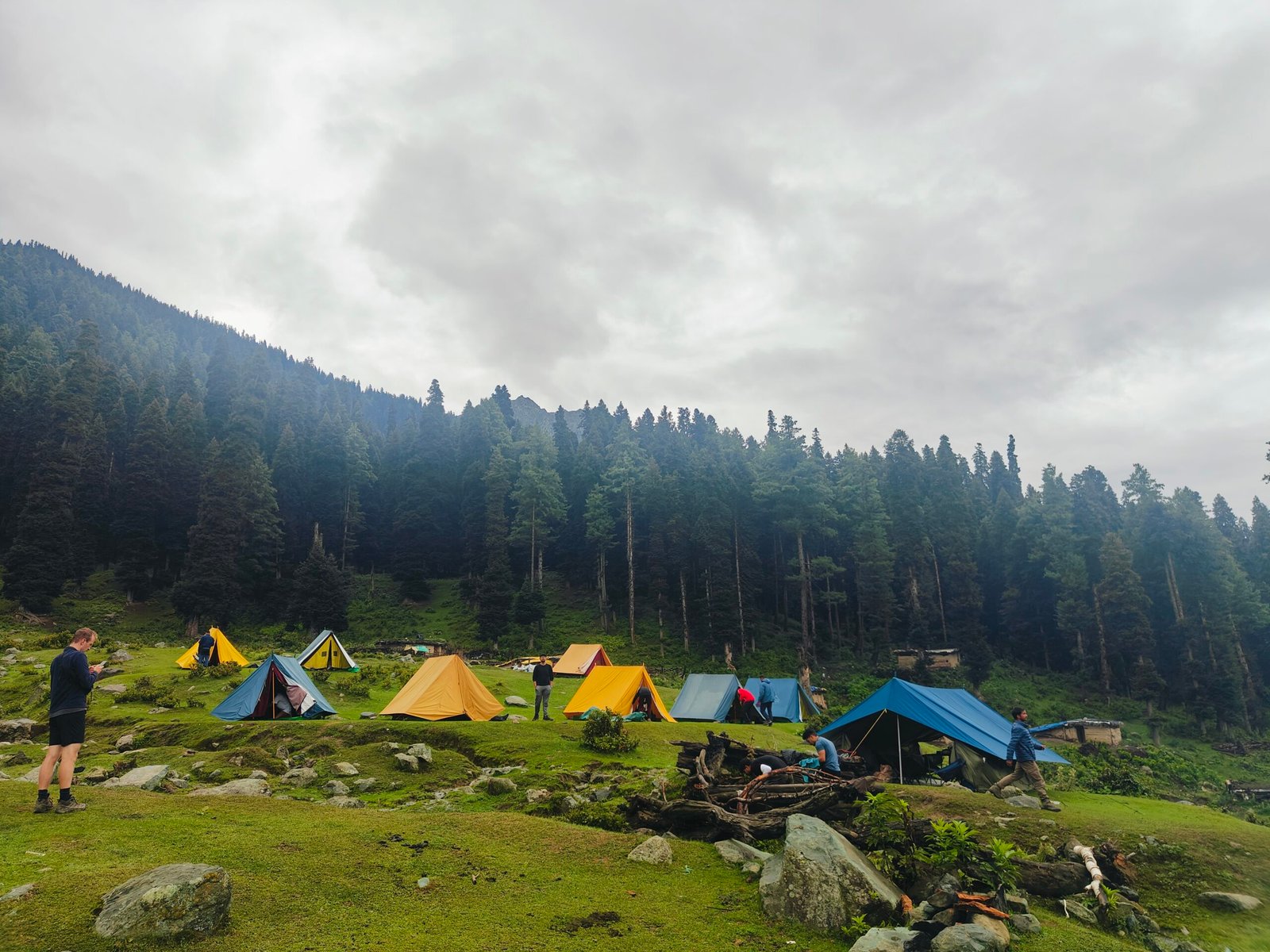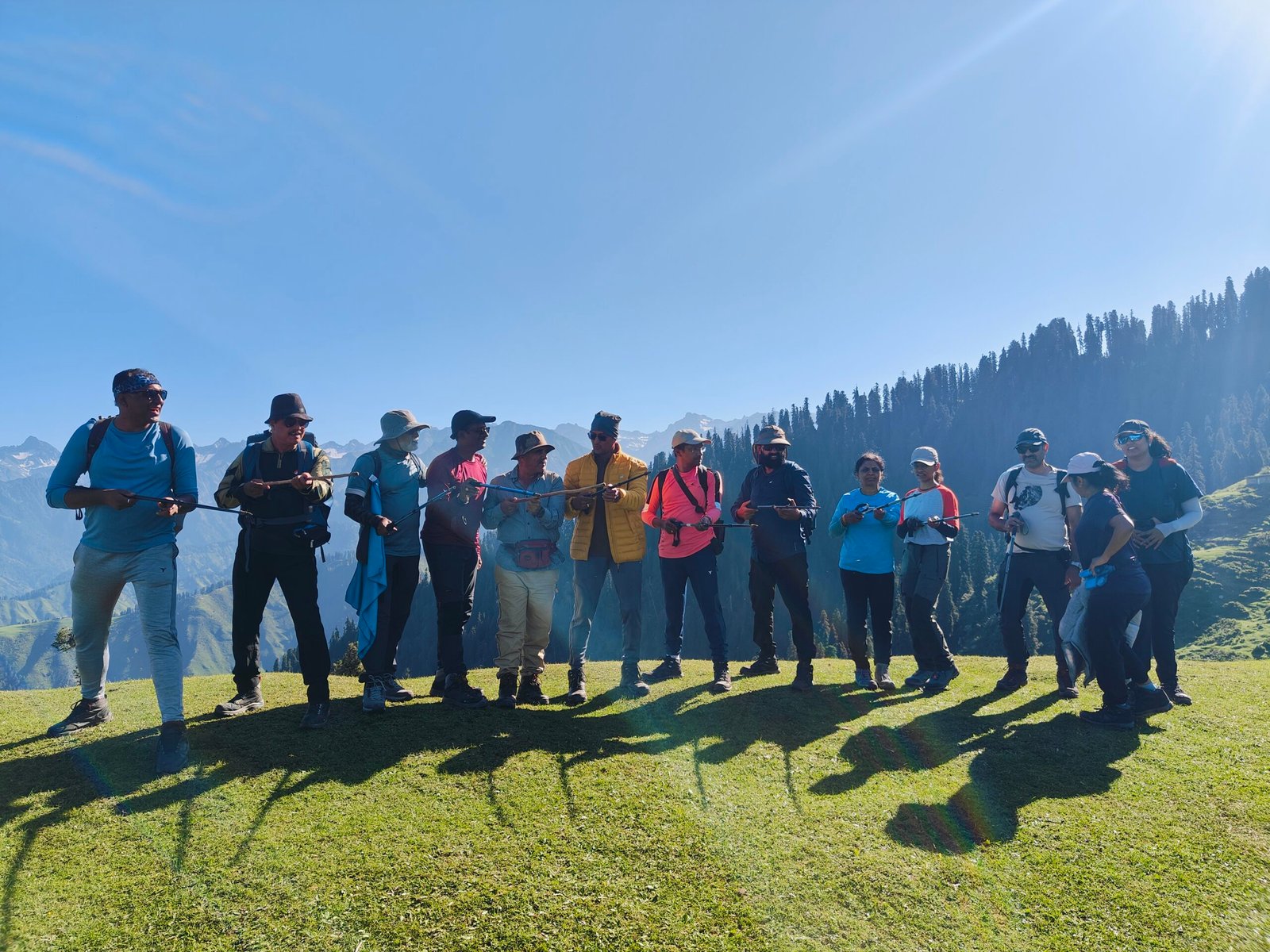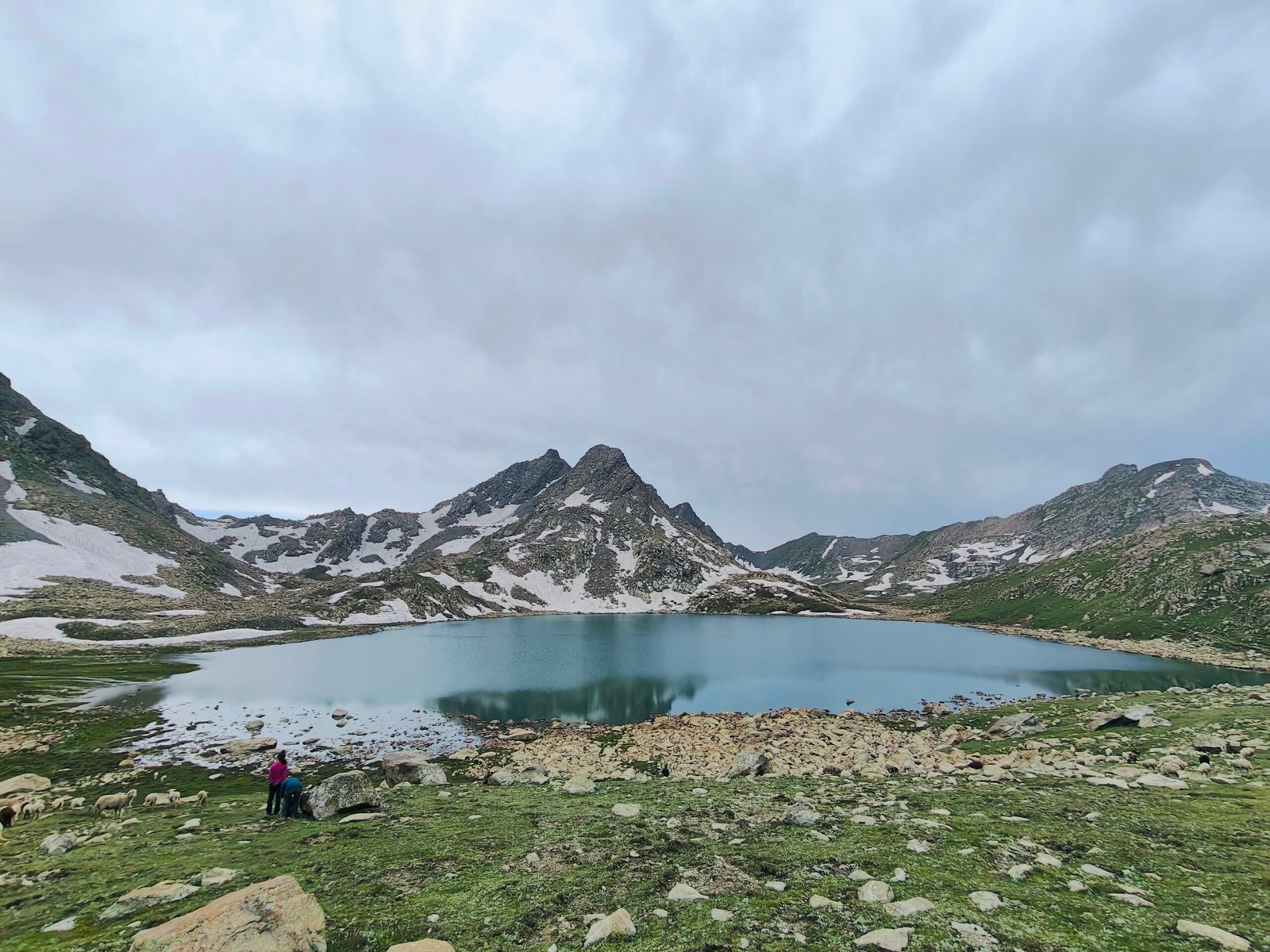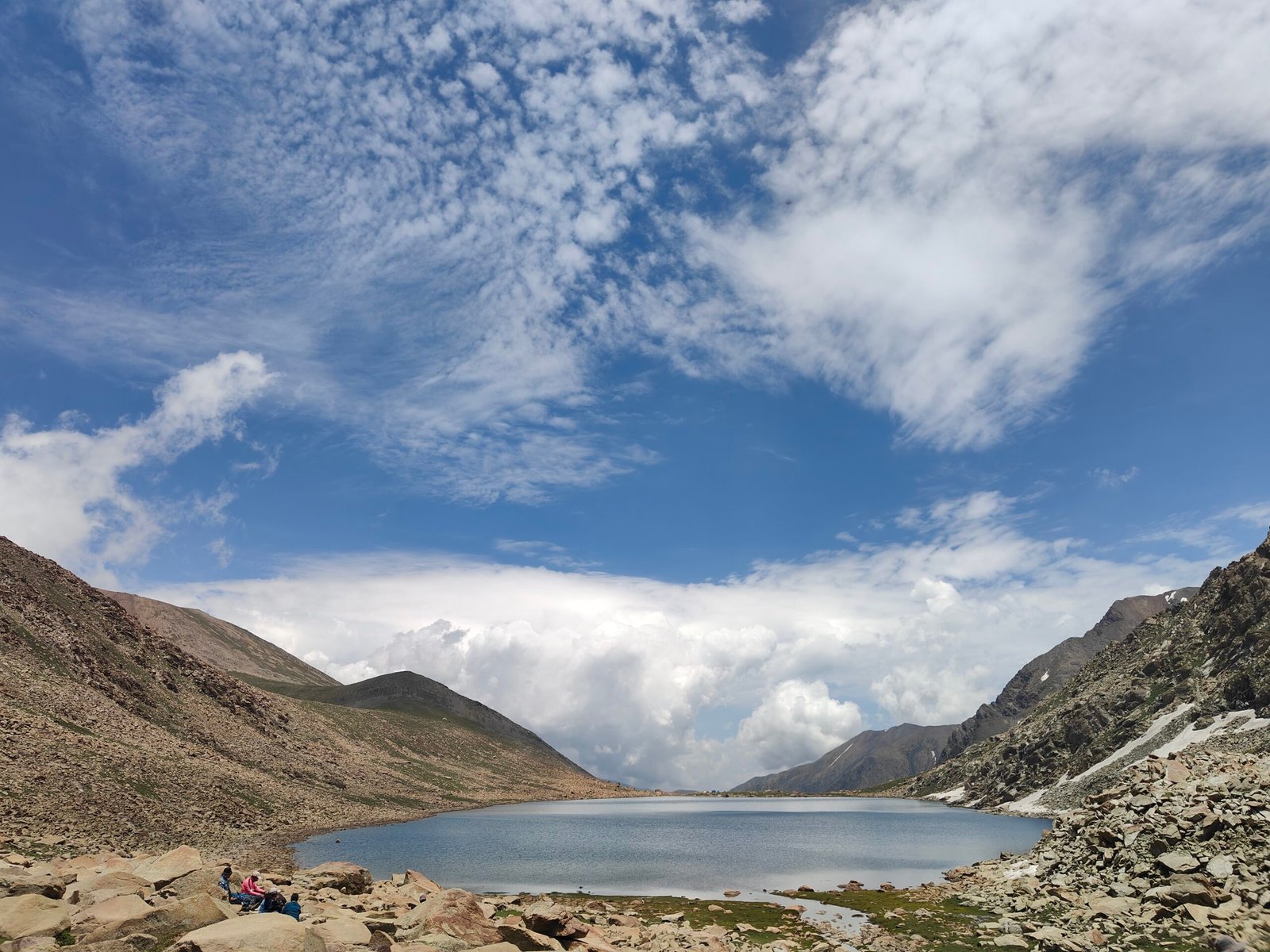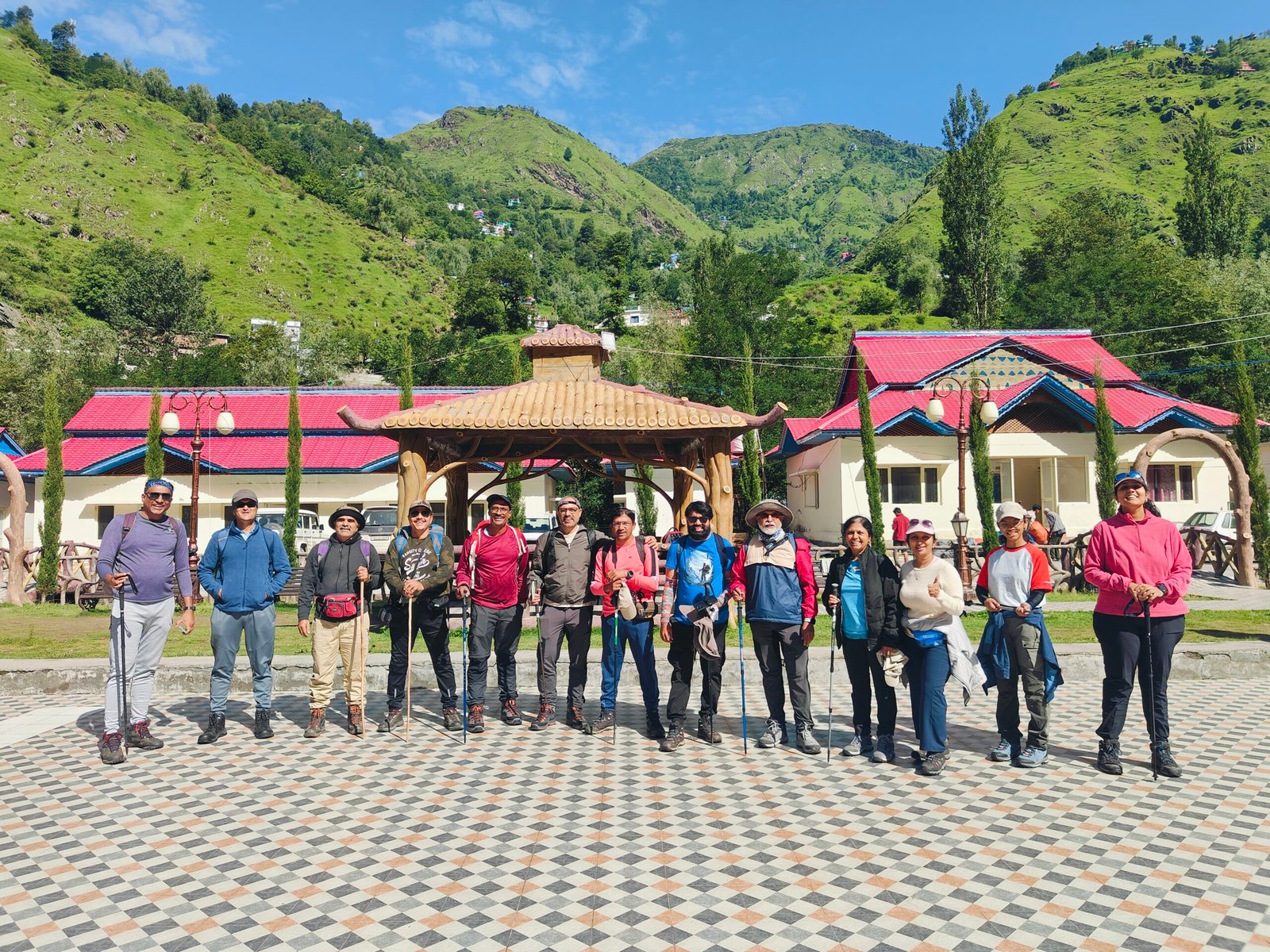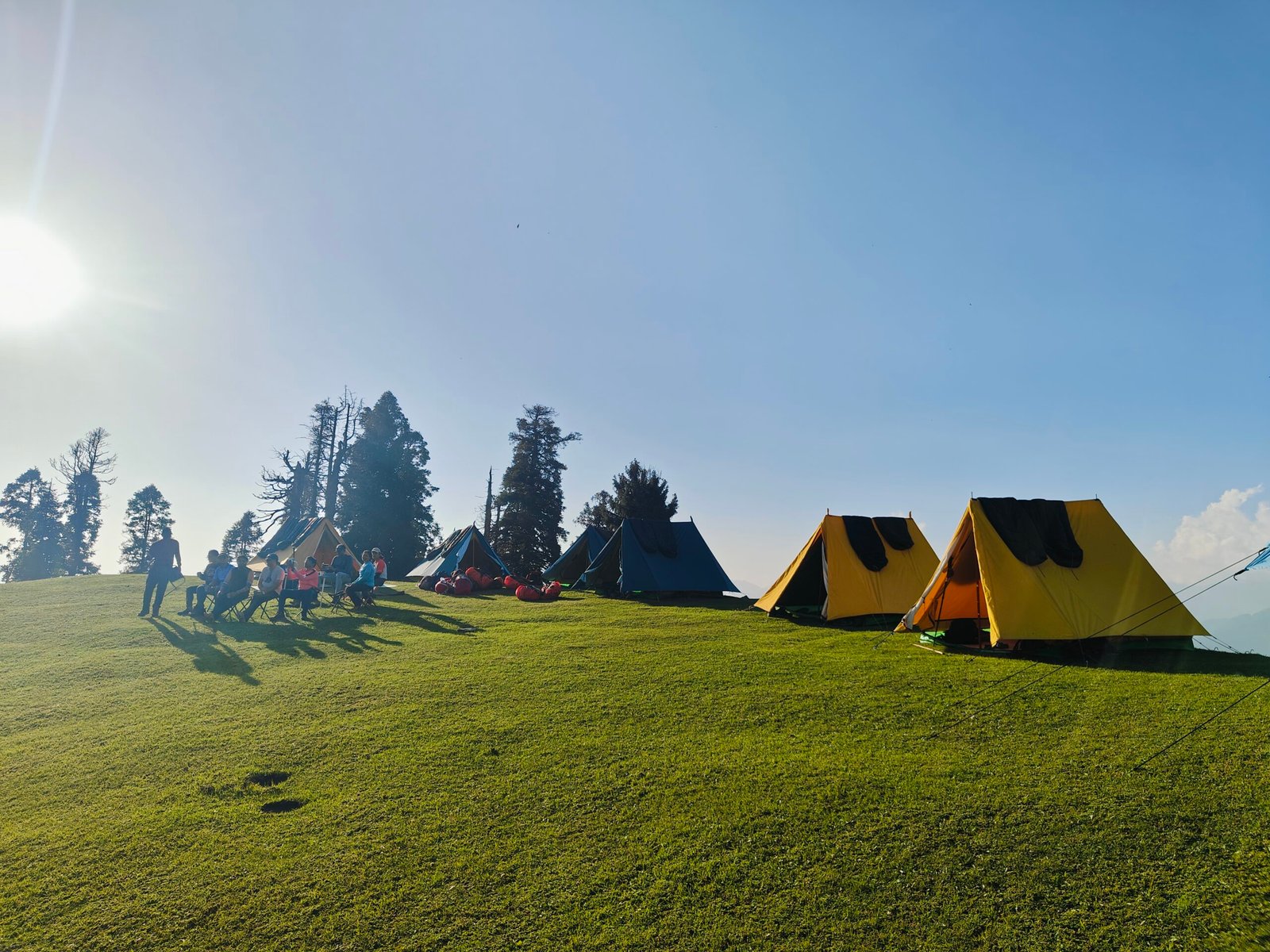Great Kashmir Lakes Trek-
Where Good Mountains can teach you
to breathe once again.
Kashmir Great Lakes Trek From Srinagar 2026 | Itinerary, Best Time & All
Region: Kashmir
Base Camp: Sonmarg
Duration: 7 Days
Altitude: 13,800 feet
Grade: Moderate-Difficult
Distance: 74 KM
Including while treks
Food
Accommodation
Instructor
First Aid
Travelling
The Valley Between Worlds :The map shows Kashmir as a mountain leaf which appears as a soft green shape that seems too perfect for natural geography. But when you land there, you realize the map is a poor translation. The air is scented with burning pine and snowmelt. The faces carry stories longer than the rivers. The region contains more than just Himalayan mountains because these mountains serve as fundamental building blocks for the communities which live there.
To a foreign traveller, Kashmir feels both known and secret. The world recognizes Kashmir through its connection to natural beauty and political conflict yet the authentic essence of Kashmir remains concealed within its peaceful landscapes and religious structures and the sounds that bounce off its icy peaks. The area extends beyond northern India because it forms a boundary region where legendary tales and towering mountains meet to create a natural environment which feels as ordinary as breathing.
Available Dates
: +91 9999301010
The Lay of the Land: Kashmir exists between the Pir Panjal range and the Greater Himalayas because of historical tectonic movements and glacial formations. The wide valleys of Sonamarg, Pahalgam, and Gulmarg receive water supplies which create a natural environment that resembles grassy and snowy landscapes. The northern mountains reach heights of 13,000 feet to create alpine meadows which look like they were painted instead of natural growth. The slopes transform into a flower garden during summer and they transform into a golden landscape during autumn under the bright and crisp sky.
The Kashmir Great Lakes Trek — or KGL, as trekkers fondly call it — passes through this living geography like a slow heartbeat. The journey takes seven days to explore five high-altitude lakes which include Vishansar, Kishansar, Gadsar, Satsar and Gangbal that receive water from glaciers while being protected by steep cliffs. Foreign trekkers experience this route as a spiritual journey through nature instead of a typical tourist path because the landscapes create sudden moments of silence.
The People and Their Pulse : The human rhythm of Kashmir is as varied as its topography. The people here are mountain-tough but soft-spoken, with an instinctive sense of hospitality that has outlived history’s noise. The Kashmiri villagers you’ll meet along the trek live lives defined by altitude — herders, carpet weavers, pony men, Gujjars, and Bakarwals — nomadic shepherds who move with the seasons. Their homes are made of wood and memory, their warmth both literal and emotional.
The Gujjar woman will invite you to join her by the fire for noon chai while a shepherd might give you a ladle of salty noon chai or kahwa without asking for anything in return except to talk. The environment creates a condition which goes beyond basic acts of kindness because it sets up a system that spreads generosity throughout the entire landscape.
Language stands as no obstacle. Even if your Hindi is halting, smiles work. The younger residents of the area know basic English which lets them share stories and give directions and talk about cricket. The older generation communicates through their eyes and their hands.
Culture in Motion
Kashmir’s cultural heritage follows the same path as its rivers which move at a gradual pace while revealing multiple layers and creating continuous reflections. The houseboats on Dal Lake in Srinagar appear like floating wooden poems while craftsmen in tight streets produce walnut wood carvings and silk weaving and pashmina shawl embroidery that resembles snowflake designs. The buildings of mosques and temples exist side by side as they have endured both weather exposure and religious devotion for many centuries.
The local food preparation methods transform ordinary ingredients into delicious dishes. The cold climate of this area reveals itself through the food which contains strong spices and fragrant flavors to create a warming effect. The food here offers a taste of cold weather through its warm and spicy fragrant dishes. The traditional preparation of Rogan Josh involves slow-cooking lamb in a thick red gravy which creates a warming taste sensation.
The local green Haak saag represents a basic mountain vegetable which chefs prepare with mustard oil to produce mountain spinach that carries a light rain-like flavor. Kahwa, the golden tea, is non-negotiable. The tea recipe includes saffron and almonds and cardamom which together produce a flavor that resembles sunlight trapped in steaming water.
The known dishes exist alongside a lesser-known category of trek food which includes meals prepared with gas burners by mountain cooks who would receive awards if they focused on making more than boiling Maggi noodles near glaciers. A simple meal of rice and dal eaten outside under the open sky provides a better taste experience than restaurant meals because of the peaceful environment with cold air and stars that feel within reach.
The Foreign Trekker’s Compass — What You Need to Know
The process of traveling as a foreign visitor to Kashmir has become simpler yet requires proper understanding and cultural respect. The closest airport to Srinagar operates flights to Delhi, Mumbai, and several other major Indian cities. The trekking agencies such as Thin Air Expeditions will handle your logistics from the moment you arrive by taking care of permits, transport, and guide arrangements.
Foreign nationals have permission to trek throughout most areas of Kashmir including the KGL route, but they must register with local authorities. Your trekking agency will handle this paperwork for you. Always carry your passport, visa, and ID copies, as security checkpoints are part of travel here — not intrusive, just routine.
The best trekking window is July to mid-September, when snow recedes and the lakes open their eyes. The trails disappear beneath the snow and rain before and after that time period. Prepare for cold nights even in August, as temperatures can drop close to freezing near higher camps.
Altitude acclimatization is crucial. Most foreign trekkers start their journey from sea level so your body requires adjustment time. A day of rest in Srinagar or Sonamarg before starting the trek can save you from altitude sickness later. Keep your body hydrated at all times.
The Way of the Trail : The Himalayas exist as a unique environment because they do not have the same level of maintenance found in European and New Zealand guided trails. The paths exist in their natural state because they contain unpredictable surfaces which consist of rocks and uneven terrain. The natural world contains its own special enchantment which makes it magical. You don’t walk on a hiking route; you walk through geography itself. The drawing appears to have been made recently because each line seems fresh.
The day begins with blue skies which gradually transform into green and ends with silver tones. The path leads you through silent valleys which create a static-like sound and shepherd dogs bark as they guard the open sky. The trekking experience becomes sacred through the experience of spending many hours alone on the path.
The environment at elevated altitudes supports only two types of natural sounds which consist of wind and water. The sound of bells from supply-carrying ponies and sheep bleating through the fog will become audible at certain times. The long hike creates a sense of accomplishment which turns solitude into a positive experience instead of making it feel like loneliness.
The Kashmiri Way — Respect and Reverence : The local people view these mountains as sacred gods which exist in a living form. The sacred lakes Vishansar and Gangbal exist because of ancient legends which connect them to Lord Shiva and the Pandavas. Show respect through your walk even if you do not believe in the same faith. The lakes must stay free from pollution and swimming is not allowed. The meadows should stay free from music.
The Invitation : The truth is, no photograph, no description, no blog can quite tell you what it’s like to wake up in a tent above 12,000 feet and unzip the flap to see a lake the color of melted sapphire. Standing at the edge of the mountain with wind blowing through your hair and clouds touching your boots will show you that written descriptions only hint at the true experience.
The Kashmir Great Lakes Trek is not only a walk-through nature — it’s a quiet entry into a civilization shaped by altitude and silence. Beauty exists as something that lasts through time instead of being a brief spectacle according to this teaching. Foreign travellers get to experience an uncommon opportunity to discover the ancient yet thriving side of India which exists in distant yet deeply human places.
Kashmir does not open itself all at once. The natural world shows its beauty through scents and silent moments and the way sunlight creates patterns across its grassy fields. The place becomes your home when it accepts you but your heart will always belong to it. Your body will produce a mild discomfort which resembles the sensation of wind when you reach sea level.
I am writing it with my trekking shoes still dirty, my pack half-packed and a trace of pine smell still running over my jacket. The Kashmir Great Lakes Trek, also commonly known as KGL trek, has been terminated, yet it does not seem like one. And even as I shut my eyes, I can see still, in the dreaminess of blue, jade, and silver, lakes, which are nestled in snow-covered mountains that I think speak themselves.
It is weird how an adventure can transform someone within a span of seven days. I came with hopes of a challenge, and got something of an equal, some humming silence, a wildness that hearkens, a Kashmir that lingers to the promise of the postcards like nothing.
It was not merely an itinerary but it changed my thought-process. However, the walk is seven days on foot, but I understood that the walk began far earlier than we got to Kashmir. This is to be done immediately after booking the package. Five weeks before I started training jogging and walking up the stairs, training on breathing.
The Thin Air Expedition team emphasized on health, hydration and acclimatization to altitude- something that was ignored frequently in the Himalayas. They even provided child-friendly rules and conditions of first-time visitors to the trek. Their premise and tone is what caught my eye most: soft but not quite aggressively, as a friend and a mentor who knows the mountains more than you do, but which desires you to discover a niche among the Himalayas.
The Thin Air Expedition team emphasized on health, hydration and acclimatization to altitude- something that was ignored frequently in the Himalayas. They even provided child-friendly rules and conditions of first-time visitors to the trek. Their premise and tone is what caught my eye most: soft but not quite aggressively, as a friend and a mentor who knows the mountains more than you do, but which desires you to discover a niche among the Himalayas.
Itinerary of Kashmir Great Lakes Trek
Landing in Srinagar I was anticipating anarchy – and I received it: the honking of cabs, the street sellers selling saffron, a pleasant aroma of kahwa in the air. But making a turn, the road grew nearer and nearer to Sonamarg and the sound diminished to silence. It was a four-hour drive, and time is weird in Kashmir. Each turn presented something previously unseen-wild horses pasture big rivers, shrivelled shepherds, fat fruit-bearing apple-trees. I asked myself: will the great Kashmir lakes trek begin quite like this? –then what will the remainder be like? When I had reached Sonamarg evening had fallen.
The golden meadows were what they were–Sonamarg, in fact, signifies meadow of gold. I joined my trekking mates and tried that evening cuddled up together, tweaked our packs and gazed at the mountains we would go through the next day in silence. Dinner was plain – hot rajma chawal, and hot kahwa in steel cups, afterwards. The sky was transformed to violet which is a Kashmir-only shade. The mountains had already damped out some of the noise in us before we started walking.
The line started off at daylight, and the atmosphere was so clear of the air that to breathe was like swallowing ice water. it was rising, slowly, slowly–green lowland, swell after swell, hand-coloured stretches of pine. Two hours later we arrived at Shekdur a cinematic meadow which might have been movie set. I was sitting there sipping a steel cup of chai and watching ponies grazing on silver mountains. It is said that once Shekdur was a resting place of the Bakarwals, nomadic herders who sometimes yet roam these ranges through with their sheds. It was late enough at sunset to cross the Nichnai stream and make camp. It was a Milky Way this night, pouring over the sky, and as bright as I has never seen it. The sound of the stream turned my lullaby, white noise of nature.
The third day was a change of direction, and it was no longer I am trekking. We started early. Our first real challenge was the Nichnai Pass which rose to 13,000 feet. Through the pass wind blew, And made your bones hum. Each one was getting heavier yet each one was becoming lighter. As we at last dropped down into the Vishansar Valley I chilled. In it Vishansar Lake glowed like molten sapphire and on its opposite end Kishansar Peak stood round it as a protector.
The water was as calm as clouds in it appeared to be confined. Locals believed that Vishansar was an incarnation of Lord Vishnu, Kishansar his brother and the two who were watching over the valley. It was a journey to the pages of mythology to walk here. That evening, I put my fingers into the crystalline, cool water, which brought me to ground. I went to bed with some exhaustion and thankfulness.
And this was the day the mountains made some tests of us. We started to ascend to Gadsar Pass, the peak of the walk – 13,800 feet above sea level. The path was steep and jagged, slashing across ridges, snow-fields and along narrow ledges. However, when we got up there, we could see the world – green valleys, blue lakes- jewels, and heaps that were so high that they ripped the clouds to pieces.
Below us was the lake of flowers or Gadsar Lake in which there had been many wild flowers. People living near it tell us it is haunted by spirits–the pure-hearted only can have clear reflections in its waters. However mythical or real, the silence in that was sacred. I told myself that evening in my journal: The higher we stand the less the world is heard. It is ironical that Kashmir trekking is the humming way in which cities fail to do.
At that point we were a family, blistered, sunburned, and joined. The path led off Gadsar to Satsar and clove through meadows, diffused boulders, and torrents of the Alps. The satsar or seven lakes take their one by one, still and out-of-the-way, mysterious.
Few of the trekkers observe all the seven. The upper lakes are frequently covered by mist. The locals believe that they were created out of the tears of a goddess because of the greediness of humankind. I stood there and felt it, because of the water and the curling of clouds.
That was a stormy night and the lightning flashed through the ridge. The tempter was fierce–the rains dharped tents, the wind sang their wild song. The sense of fear, awe, and stronger sense of belonging came over my mind.
It was a steep precarious route to Gangbal and Nandkol. We scrambled on boulders, waded streams and climbed till we choked with gasping breath. Two lakes suddenly came into view below Mount Harmukh and were like twin mirrors. It is believed that Gangbal Lake is the Ganga of Kashmir, the deity of Lord Shiva. Its smaller twin, Nandkol, repeats the same peak at a different angle- such as the yin and yang of the Himalayas. We sat quietly round the sun gilding of Harmukh. Someone was whistling a melody; time seemed to have come to an end.
The 7-lakes hike in Kashmir is not based on the quantity of lakes but rather those experiences when you lose yourself and encounter something more authentic.
The trail up to Naranag was a man-killer, 14 km of rocky slopes and sore knees, but it was attractive, too. The alpine landscape was becoming a pine-forest, then it became oak-forest and finally a moss-forest. We were dirty and exhausted and high, by the time we came to Naranag. The old temples were lifeless, carved stone, a part of which crumbled, yet endless. It was poetic how our great lakes quest to Kashmir terminated where earlier pilgrims used to pray.
When the jeep made its way back to Srinagar, I understood that there is no end to a trek when one takes it down the mountain- it reverberates. Each lake, promontory, quiet remains leathered on your bones.
Local Flavors What Kashmir Tastes Like.
Food on the hike is not just energy, but it is memory.
At Shekdur a Gujjar woman had served us roti with buttered churned in the morning. We took rajma-chawal at Gadsar and our cook had smoked it into home taste.
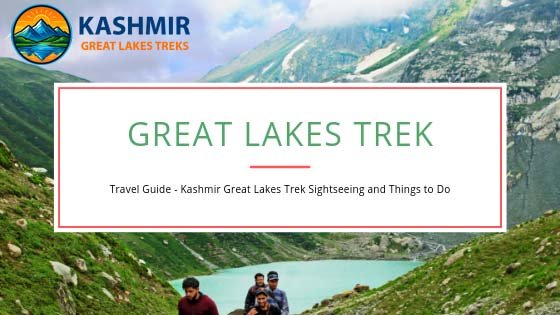
At Kashmir Great Lakes later do not miss:
Every bite is as the valley itself- sublime and powerful and memorable.
- Kahwa: tea flavoured with spices and saffron which smells warm.
- Gushtaba: mince balls made of mutton in yogurt gravy.
- Haak saag and Kahchar wild greens fresh out of the hills.
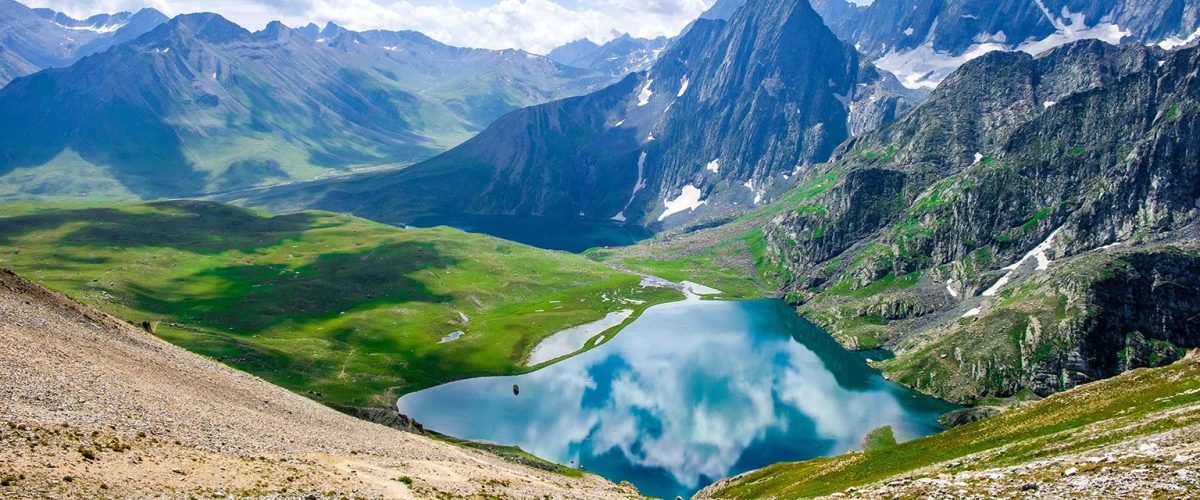
What is the most appropriate time of the year to do Kashmir Great Lakes Trek?
- Best time to start the trek is beginning of July to mid-September in case you are planning the trip.
- July- fields in blossom, snow thawing, streams raging.
- August- weather of equilibrium, lake reflections.
- September– lonely deep trails, gold backs, pure solitude.
This is why trekkers claim that this is the most appropriate period to have the Kashmir Great Lakes Trek this is a very short season when the sky opens up briefly.
The Science of Beauty -The Why of Lakes that shines like jewels.
Not enchanted, it is glacial physics.
The lakes are coloured by rock flour–minute glacial silt which diffracts the sunlight in varying degrees with depth and grittleness. This is why Vishansar appears to be turquoise, Kishansar is emerald and Gangbal is deep blue.
They are clear because of low level of algae -at 10,000-13,000 ft there is too little oxygen to support much growth. What is obtained is the reflections that challenge reality shaped like glass.
Flora and Fauna, The Living Soul of the Trail.
It is not about lakes, but life within the KGL trek.
You will pass by the fields with blue poppies, purple irises, wild daisies, and pink bistort. These flowers are growing on a very high altitude, and they have a flowering period of six to eight weeks before being superseded by snow.
Wild life is timid and widespread–Himalayan marmots, red fox, golden eagle and in a few instances, black bears along the woods. The steep areas have ibex and infrequently the evasive snow leopard.
This heterogeneity is very threatened here–with each stride you are made to recall that you are entering their kingdom to stay as their guest.
The Trek Folk- The Gujjars and Bakarwals.
Hopefully, you will come across the Bakarwals, nomadic shepherds in different valleys who wander around offering sheep to the different valleys in quickly changing places. They have uncomplicated camps: wool tents, smouldering fires, laughter that rings over meadows.
They can call you to drink salt tea prepared of goat milk and butter. One might not love it, but the affection behind it is hard to forget. They have children which run naked on the grass and wonder about the people on a trek, but are not afraid. Some evening, close by Satsar, we were told by one of the old Gujjar shepherds, that these mountains are not our own, but that we are theirs. I do still have that sentence hanging on me.
Local Cuisine
Kashmir on the Trail- A Taste of Kashmir. Without mentioning its food, you cannot discuss trekking in Kashmir.
Among these treasures before and after the trek do not miss:
- Rogan Josh- slow cooked mutton in warm Kashmiri spices.
- Gushtaba -meatballs made of minced meat in creamy yogurt curry.
- Modur Pulao- dry fruits saffron rice.
- Haak Saag – spinach dish is plain and wholesome.
- Kahwa -green tea that is combined with cardamom, saffron, and almonds offered everywhere, particularly at the end of the tedious trek day.\
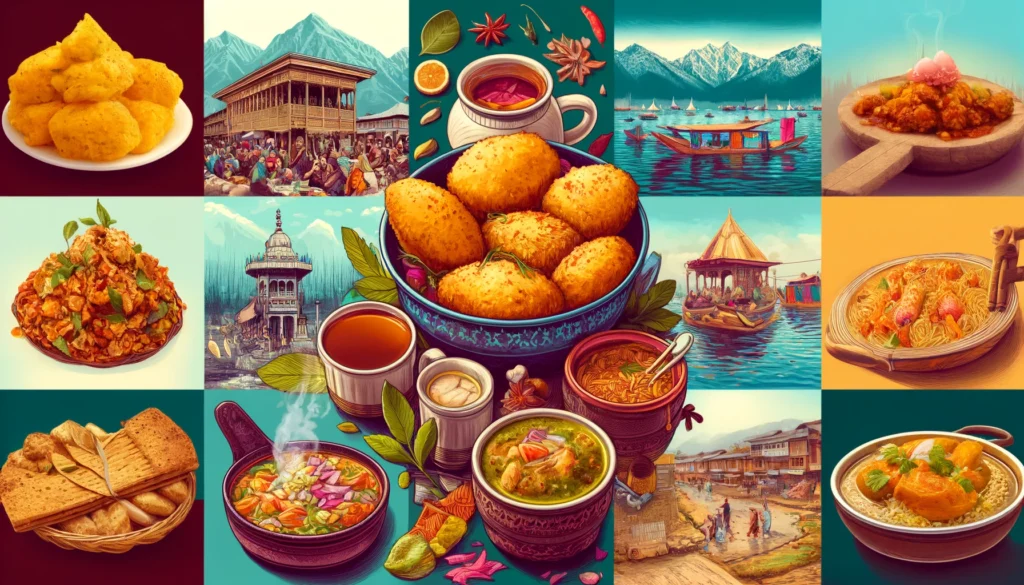
On the way out, your food is plain – dal, rice, roti, and soup.
However, trust me the food of any five-star restaurants can never be compared with Maggi at the side of the lake of Vishansar with the steam to the mountain air.
Photography Depths — Photographing the Soul of Kashmir.
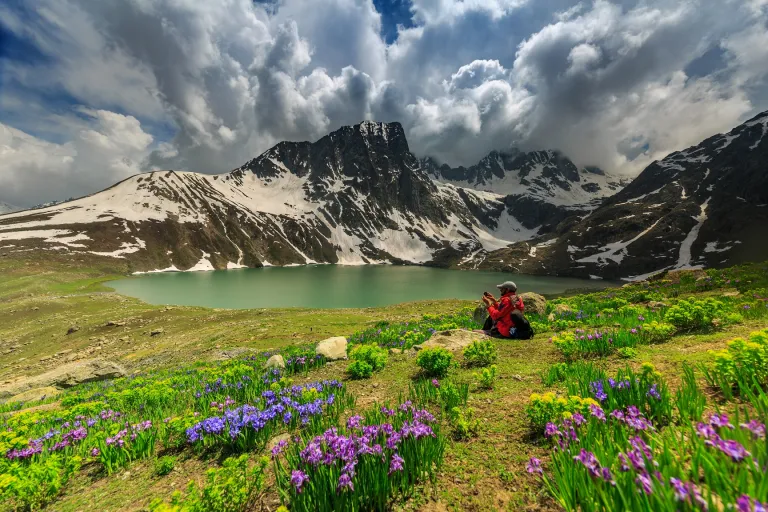
The great lakes trek -Kashmir seems like a dream to a photographer but it is easy to lose track and lose the camera.
The following are some of the things I learned:
- Golden hours are magic. The colour of sunrise at Vishansar and sunset at Gangbal fill your camera with disbelief.
- Meadows are to be taken in large angles; distant ridges should be taken with zoom lenses.
- Take more batteries, they make them around with a cold.
- Don’t over-edit. There is no need of filters on the beauty here.
- Sometimes, just watch. There are frames which are designed to be stored in the memory.
- The photography in this is not about capturing, but being witness to.
Preparation and Essentials- What I Went through the Hard Way.
Pack light but smart. Here’s my honest checklist:
- Base (thermal), mid (fleece), outer (windproof) layers.
- Waterproof jacket and pants.
- Ankle support trekking shoes.
- Headlamp – power failures are common in camps.
- Water bottle + purifying tablets, reusable.
- Trekking pole – your new best friend on the downhill.
- Quick-dry towel and socks.
- Snacks to carry along with them–plugins, dry fruits and jaggery in case of fatigue in the altitude.
And in feelings- get ready to part. No cell phone connection, no Internet modem, no distraction. You and your thought alone resonating in Himalayas.

Leave Only Footprints; the responsible Trekking.
The trails in Kashmir are fragile ecosystems. I also came to know this by observing a local guide picking up candy wrappers that had been left by other people. He told, the mountain will not forget.
So:
- Carry your trash back.
- Don’t wash near lakes.
- Keep off loud music – here silence is sacrosanct.
- Hire local carriers and purchase local food.
The question is not whether it is sustainable or not, it is a matter of respect.
FAQ's of Kashmir Great Lakes Trek
The most famous Kashmir Treks are Kashmir Great Lakes (KGL), Tarsar Marsar, Tulian Lake, Gangbal Lake, and Naranag to Gangbal. Each trek offers different flavor, such as, alpine lakes, meadows, and breathtaking Himalayan backdrop.
Ideally, the trekking window opens from mid-June to mid-September. Meadows are in the full bloom as snow starts to melt. And lakes are finally accessible. And that is why trekkers come-for the 7 lakes trek.
Most of the Jammu and Kashmir treks are considered moderate to difficult, demanding prior trekking experience and basic fitness. KGL (most popular trek in Kashmir) and Tarsar Marsar are moderate level treks and can be attempted by the beginners with preparation.
The water was as calm as clouds in it appeared to be confined. Locals believed that Vishansar was an incarnation of Lord Vishnu, Kishansar his brother and the two who were watching over the valley. It was a journey to the pages of mythology to walk here. That evening, I put my fingers into the crystalline, cool water, which brought me to ground. I went to bed with some exhaustion and thankfulness.
Most treks start from Srinagar. Your trekking agency picks you from Srinagar and drops at the base village. Trekkers can reach Srinagar by road or by flight. You can also hire a sharing or personal cab till base camp.
- For KGL, the base camp is in Sonamarg (Shitkadi village).
- For Tarsar Marsar, the base camp is Aru village (Pahalgam).
Identity verification and forest permits are mandatory to trek in Kashmir. Trekking agency usually arranges it. For foreign nationals additional permission from local authorities is required.
Yes. The trekking routes are managed and patrolled frequently. On most trails local guides and army camps are present for the safety.
Different treks in Jammu and Kashmir have different duration;
- KGL Trek requires 7–8 days to complete
- Tarsar Marsar needs 6–7 days minimum
- Tulian Lake is one of the shortest treks taking 3–4 days to complete
- Naranag–Gangbal will take 5 days
Great lakes trekking is the longest trail with tricky sections, it stands at the altitude of13,750 ft
Tarsar Marsar is situated at the elevation of 13,200 ft
Kashmir lakes trek opens in the summer season and maximum temperature in day could be 10°C to 20°C and 0°C to -5°C in night. Carry warm layers.
Mobile signals start getting weak from the base village (Sonmarg or Aru) itself and vanishes completely as enter the trail. BSNL/Jio might work partly in.
Trekkers get to stay in guesthouse/homestay at the base camp and in comfortable sharing tents during the trek. (Personal tents can be arranged on prior request).
Yes, beginners can definitely do treks like the Kashmir Great lakes Trek and Tarsar Marsar with good fitness. If you are a first time trekker and haven’t done workout in a while then start with basic training such as, jogging, stair climbs, cardio and trek under professional guidance.
Always trek with group, even if you are solo. Book your trek with the certified trekking agency. This will ensure you are safe and under expert eye. Don’t go solo as the terrain is remote, far from the civilization, and has zero network range.
With a loaded backpack you should be able to walk at least 10 to 12 kilometers daily. You can do cardio, running, and cycling to build the stamina. Do all this for a month before the trek.
Thin Air Expedition shares checklist of essential trekking gear with their trekkers before the trek begins. You can always ask for the checklist and have questions for the same; they will guide you. Here are some basic important essentials;
- Warm layers, rain jacket, trek pants
- Waterproof trekking shoes
- Gloves, woollen cap, sunglasses
- Trekking poles, headlamp, and personal meds
If you choose Kashmir Trekking between the months of June–mid-July, you will find patches of snow, especially when you come across high-passes, like Gadsar or Nichnai.
Do not attempt to swim in the alpine lakes as they are super icy. You can always dip your hands and feet to get refreshed. It is recommended to dry your feet if wet as there will be enhanced chances of getting blisters.
Meals are included in the Kashmir trek package. First day you get dinner and from next day till the trek ends you are served with delicious four meals, comprising, breakfast, lunch, evening snacks, and dinner. Thin Air Expedition has designed proper nutritious based vegetarian dishes for its clients like dal, rice, roti, sabzi, and soup. Always carry extra snacks like energy bars and dry fruits for quick energy boost during the trek.
The altitude is moderate; however, some trekkers may face slight AMS symptoms. Stay hydrated, keep sipping water in little amount, don’t rush, immediately inform your trek leader about your condition (dizziness, headache, or breathlessness).
Doesn’t matter which trek you choose in Kashmir, every trail is a live painting- expansive meadows, turquoise lakes, snow-clad peaks, and shepherd huts offer a view right from the movie. It’s time to experience the rawness of untouched Himalayan beauty.
What Mountains Leave Behind the Emotional Aftermath.
It has been days since I came back, but even today, I do wake up hoping that I would unzip a tent, and Vishansar would shine in the morning light.
The KGL walk did not only present landscapes to me, it gave me tranquillity. It made me know that it is not about conquering anything but making mountains let you go.
When individuals pose the question, great lake trek of Kashmir, was it worth it?
I explain to them; it was more than worth it it was transformative.
Out there between the lakes and the sky, how small you are, you see, and what liberating that smallness can be.
So next time you are adrift, just walk in the great lakes of Kashmir. Somewhere, in between the mirror and the hymn of Gangbal, somewhere the mountains will tell you the version that you always should have been.
